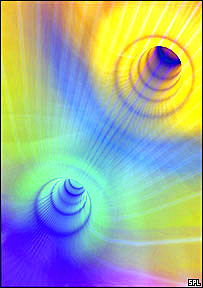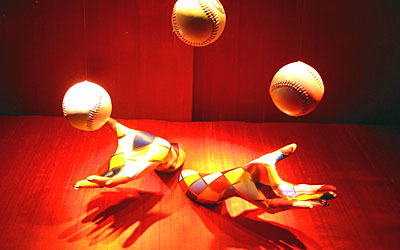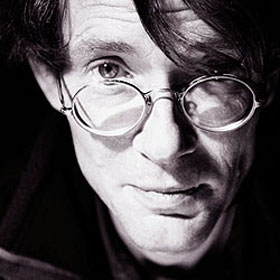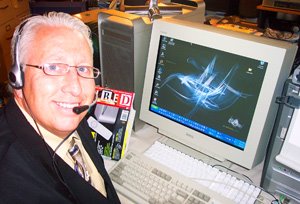Got The Time?
:: Physicists have found the law of nature which prevents time travel paradoxes, and thereby permits time travel!
++ John Gribbin / Time Travel For Beginners
What allows time travel to be possible turns out to be the same law that makes sure light travels in straight lines (and which underpins the most straightforward version of quantum theory, developed half a century ago by Richard Feynman).
 Relativists have been trying to come to terms with time travel for the past seven years, since Kip Thorne and his colleagues at Caltech discovered (much to their surprise) that there is nothing in the laws of physics (specifically, the general theory of relativity) to forbid it. [Image credit: Sanja Gjenero, Zagreb, Croatia]
Relativists have been trying to come to terms with time travel for the past seven years, since Kip Thorne and his colleagues at Caltech discovered (much to their surprise) that there is nothing in the laws of physics (specifically, the general theory of relativity) to forbid it. [Image credit: Sanja Gjenero, Zagreb, Croatia] Among several different ways in which the laws allow a time machine to exist, the one that has been most intensively studied mathematically is the "wormhole". This is like a tunnel through space and time, connecting different regions of the Universe (different spaces and different times). [To view my post about a "Macroscopic Tranversable Spacewarp!", click here.]
Among several different ways in which the laws allow a time machine to exist, the one that has been most intensively studied mathematically is the "wormhole". This is like a tunnel through space and time, connecting different regions of the Universe (different spaces and different times). [To view my post about a "Macroscopic Tranversable Spacewarp!", click here.]The two "mouths" of the wormhole could be next to each other in space, but separated in time, so that it could literally be used as a time tunnel.
What has made time travel seemingly impossible is the possibility of paradoxes. What if a time traveler goes back in time and accidentally kills his or her grandfather? If you killed your grandfather before you were born, how could you be born and travel back in time to kill your grandfather? The list of possible paradoxes is endless.
 Watch the excellent movie "Somewhere In Time", and try to answer the following question: Where did the watch come from (for a decent answer to this question, click here)?
Watch the excellent movie "Somewhere In Time", and try to answer the following question: Where did the watch come from (for a decent answer to this question, click here)? How great would it be if we could simply pause life, rewind a mistake, or fast-forward through an exam? Or go back (or forward) to our future in order to see the consequences of our present decisions.
How great would it be if we could simply pause life, rewind a mistake, or fast-forward through an exam? Or go back (or forward) to our future in order to see the consequences of our present decisions.If time travel really is possible (after seven years of intensive study, all the evidence says that it is - although maybe not in a Delorean) there must be a law of nature to prevent such paradoxes arising, while permitting journeys through time.
Igor Novikov, who holds joint posts at the P. N. Lebedev Institute, in Moscow, and at NORDITA (the Nordic Institute for Theoretical Physics) in Copenhagen, first pointed out the need for a "Principle of Self-consistency". Now, working with a large group of colleagues in Denmark, Canada, Russia and Switzerland, he has found the physical basis for this principle.
 It involves something known as the Principle of least action (or Principle of minimal action), and has been known (in one form or another) since the early seventeenth century. It describes the trajectories of things, such as the path of a light ray from A to B, or the flight of a baseball tossed through an upper story window. [Image credit: H. Destreich, Franfurt, Hessen, Germany]
It involves something known as the Principle of least action (or Principle of minimal action), and has been known (in one form or another) since the early seventeenth century. It describes the trajectories of things, such as the path of a light ray from A to B, or the flight of a baseball tossed through an upper story window. [Image credit: H. Destreich, Franfurt, Hessen, Germany]Action, in this sense, is a measure both of the energy involved in traversing the path and the time taken. For light (which is always a special case), this boils down to time alone, so that the principle of least action becomes the principle of least time, which is why light travels in straight lines.
Feynman, who was entranced by the principle of least action, formulated quantum physics entirely on the basis of it, using what is known as the "sum over histories" or "path integral" formulation, because, like a light ray seemingly sniffing out the best path from A to B, it takes account of all possible trajectories in selecting the most efficient.
 So self-consistency is a consequence of the Principle of least action, and nature can be seen to abhor a time travel paradox. Which removes the last objection of physicists to time travel in principle. This leaves it up to the engineers to get on with the job of building a time machine. [Image credit: Daniel Cardle]
So self-consistency is a consequence of the Principle of least action, and nature can be seen to abhor a time travel paradox. Which removes the last objection of physicists to time travel in principle. This leaves it up to the engineers to get on with the job of building a time machine. [Image credit: Daniel Cardle]Note from Technophile: The "action" is a property of the whole path, and somehow light (or "nature") always knows how to choose the cheapest or simplest path to its goal. In a similar fashion, the principle of "least action" can be used to describe the entire curved path of a baseball thrown through a window (once the time taken for the journey is specified). Although the ball can be thrown at different speeds on different trajectories (higher and slower, or flatter and faster) and still go through the window, only trajectories which satisfy the Principle of least action are possible. In a mathematical tour de force, Novikov and his colleagues have shown that only self-consistent solutions to the equations satisfy the principle of least action. In their own words, "the whole set of classical trajectories which are globally self-consistent can be directly and simply recovered by imposing the principle of minimal action".:: Source: [Time Travel For Beginners]
:: Innovation: Being able to travel forward and backwards in Time!
:: Available: Unknown.
:: Cost: Unknown.




















2 Comments:
I'm not by any means, a scientist but it seems I hear that light always travels in a straight line constantly.
I can't see how this is true. A candle lights the entire room, 360 degrees from the source. Light only travels in a straight line when we tell it to. By focusing it with some type of lens or device we can make it do what we want, telling it to only light up this area. For instance, we can light up the entire earth (360 degrees) by using the sun and a collection of mirrors.
I don't know if this applies to anything but it seems to me that light radiates in all directions from the source and goes wherever it can until it hits and object and is absorbed, reflected or refracted.
Like I said, I’m not educated in physics but this is just what came to mind while reading your web page. Which by the way, is very cool!
Thanks for listening and thanks for posting such an interesting web page.
Sincerely,
bootsinbed@aol.com
Hello bootsinbed,
Thank you for your comment and your kind remarks.
Yes it is true that the light from a candle (or light bulb) radiates outward from it's source, although it may not be entirely accurate to say it radiates 360 degrees from it's source (this implies two-dimensional thinking). It actually radiates in all directions from its source.
However, let's say you're on a ship and you're looking at a lighthouse. The light from this lighthouse travelled in a relatively straight line to get to your eye. (I say "relatively" because it is travelling through air, which may vary in density).
If the light travelled in a curved line, it would be difficult for you to be able to accurately determine where it came from.
The reality is that light can actually curve (under the influence of gravity), and it can change direction if it passes through an atmosphere that changes density (such as air or water), and yes it can be reflected, absorbed, etc.
However, light travelling through a vacumm (such as space) that is not near a gravity influence (such as stars, planets, moons or other space bodies) will always travel in a straight line (from its source).
Post a Comment
<< Home